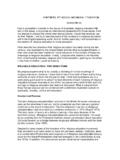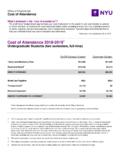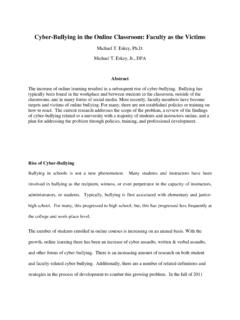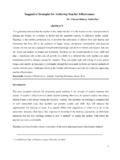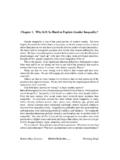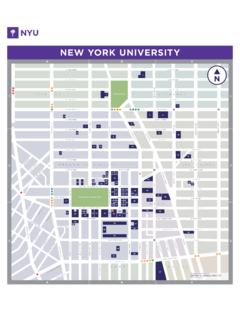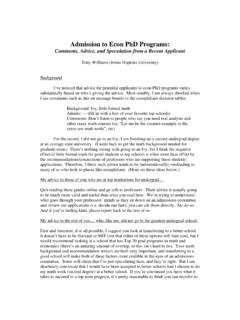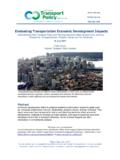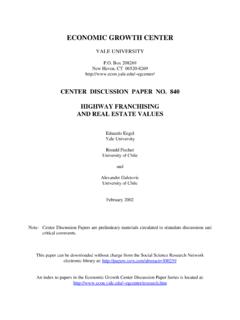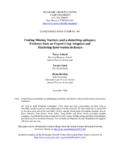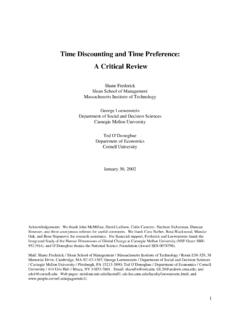Transcription of GENERAL PURPOSE TECHNOLOGIES - nyu.edu
1 Chapter 18 GENERAL PURPOSE TECHNOLOGIESBOYAN JOVANOVICNew York UniversityandNBERPETER L. ROUSSEAUV anderbilt UniversityandNBERC ontentsAbstract1182 Keywords11831. What is a GPT? Summary of Similarities between the Electrification and IT Differences between the Electrification and IT eras11862. Measuring the three characteristics of a Pervasiveness of the Pervasiveness in the Pervasiveness among Adoption by On dating the endpoints of a GPT Improvement of the Ability of the GPT to spawn Investment by new firms vs. investment by incumbents12003. Other symptoms of a Productivity The skill Entry, exit, and mergers should Stock prices should fall1207 Handbook of Economic Growth, Volume 1B.
2 Edited by Philippe Aghion and Steven N. Durlauf 2005 Elsevier All rights reservedDOI: (05)01018-X1182B. Jovanovic and Young firms should do The age of the The age of firms at their The stock market performance of the young vs. old after Consumption, interest rates, and the trade The trade The consumption income Interest rates12204. Conclusion1221 Acknowledgements1221 References1221 AbstractA GENERAL PURPOSE technology or GPT is a term coined to describe a new method ofproducing and inventing that is important enough to have a protracted aggregate and information technology (IT) probably are the two most important GPTsso far.
3 We analyze how the economy reacted to them. We date the Electrification erafrom 1894 until 1930, and the IT era from 1971 until the present. While we documentsome differences between the two TECHNOLOGIES , we follow David [In:Technology andProductivity: The Challenge for Economic Policy(1991) 315 347] and emphasize theirsimilarities. Our main findings are:1. Productivity growth in the two GPT eras tended to be lower than it was in otherperiods, with productivity slowdowns taking place at the start of the two eras andthe IT era slowdown stronger than that seen during Both GPTs were widely adopted, but electricity s adoption was faster and moreuniform over Both improved as they were adopted, but measured by its relative price decline,IT has shown a much faster improvement than Electricity Both have spawned innovation, but here, too.
4 IT dominates Electricity in terms ofthe number of patents and trademarks Both were accompanied by a rise in creative destruction and turbulence as mea-sured by the entry and exit of firms, by mergers and takeovers, and by changingvaluations on the stock sum, Electrification spread faster than IT has been spreading, and it did so moreevenly and broadly over sectors. Also, IT comprises a smaller fraction of the physicalcapital stock than electrified machinery did at its corresponding stage. On the otherhand, IT seems to be technologically more dynamic; the ongoing spread of IT and itscontinuing precipitous price decline are reasons for optimism about productivity growthin the 21st 18: GENERAL PURPOSE Technologies1183 Keywordselectricity, information technology, IT revolution, productivity slowdowns, technologyimprovement, creative destructionJEL classification:O3,N21184B.
5 Jovanovic and Rousseau1. IntroductionThe term GENERAL - PURPOSE technology , or GPT, has seen extensive use in recent treat-ments of the role of technology in economic growth, and is usually reserved for changesthat transform both household life and the ways in which firms conduct business. Steam,electricity, internal combustion, and information technology (IT) are often classified asGPTs for this reason. They affected the whole (1991)has pointed out, however, a GPT does not deliver productivity gainsimmediately upon 1shows the evolution of the growth in output per man-hour in the economy over the past 130 years, with periods of rapid diffusion of thetwo major GPTs shaded and the dashed line representing long-term trends as generatedwith the Hodrick Prescott (HP) growth was apparently quite rapidduring the heyday of steam power (c.)
6 1870), but fell as Electrification arrived in the1890s, with the defining moment in the transition probably being the startup of the firsthydro-electric facility at Niagara Falls in 1894. It was only in the period after 1915,which saw the diffusion of machines operated by stand-alone secondary motors and thewidespread establishment of centralized power grids, that Electricity finally pervadedbusinesses and households more generally and measures of productivity began to 1also shows that the arrival of IT, which we date with Intel s invention in 1971of the 4004 microprocessor (the key component of the personal computer or PC ),did not reverse the decline in productivity growth that had begun more than a decadeearlier.
7 It seems only now that we are finally seeing computers show up in the produc-tivity it is not obvious that the startup of the Niagara Falls dam and the inventionof the 4004 chip should define the birth of the two GPTs. After all, Thomas Edisoninvented the incandescent bulb in 1879 and by 1882 the world s first large central powerstation had been installed at Pearl Street in New York City, twelve years before we markElectricity s arrival . And large mainframe computers predicted the winner of the Presidential election, nearly two decades prior to the advent of the objective measure is needed, though, and we shall define the start of a GPT era asthe point in time when the GPT achieves a one-percent diffusion in the median is another way to arrive at 1894 and 1971 as the starting points where the shadingbegins inFigure 1.
8 Similarly, we would say that the era is over when the diffusion curveflattens out. For Electrification, it takes until about 1929 for net adoption to reach aplateau, whereas new adoption of IT is still rising today so that, on that criterion, the ITepoch shaded area inFigure 1contains a productivity-growth slowdown in its initialphases. Will the growth slowdown of the current IT era be followed by a rise in growth1 Output per man-hour in the business, non-farm sector is from John Kendrick s series as published of the Census (1975, Series D684, p. 162)for 1889 1947 and from the Bureau of Labor Statisticsfor 1948 2003.
9 For 1874 1889, we use Kendrick s decadal averages for 1869 1879 and 1879 1889 andinterpolate between these benchmarks assuming a constant growth rate from 1874 1884 and 1885 18: GENERAL PURPOSE Technologies1185 Figure 1. Annual growth in output per man-hour, 1874 the first half of the 21st century? If the second shaded area inFigure 1is in somefundamental respects like the first shaded area, then we can expect growth to pick upover the next several decades. InJovanovic and Rousseau (2002a)we have argued thatthe first half of the 21st century will have higher growth than, say, the 1950s and (2000), on the other hand, is pessimistic, arguing that IT does not measure upto Electricity and that it will not have such positive results.
10 This chapter, while docu-menting key differences between the diffusion paths of the two TECHNOLOGIES , will in theend conclude that the two GPT eras are strikingly similar in a number of respects. Ifanything, our finding that IT is the more revolutionary of the two GPTs suggests thatits full impact is yet to be chapter is organized around the presentation of a collection of facts. The facts aredescribed mainly through graphs and tables which provide evidence on a set of modelsthat we shall mention as we go along. A primarily analytic survey isGreenwood andJovanovic (2001). What is a GPT?So, what are these fundamental features of GPTs that would allow us to compare oneto another?

